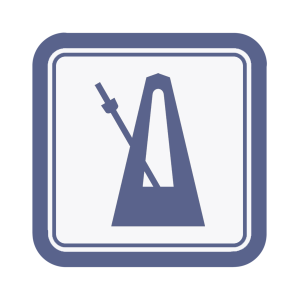
Tempo and the Beat
Learn about syncopation and the pulse, upbeats and downbeats, tempo, and straight vs. swung jazz rhythm.
After completing this module: You will understand simple rhythms, downbeats and upbeats, and straight vs. swung jazz rhythm.
Become a jazz rhythm guru and master simple rhythms and tempo with this module about syncopation, the pulse, and rhythm.
Module Preview
Contents
- Introduction
- The Pulse
- Downbeat vs. Upbeat
- Tempo
- Tips for Learning Tempo
- What is Syncopation?
- Practice the Beat
What is Tempo?

The Tempo of a piece of music determines the speed at which it is played, and is measured in beats per minute (BPM). The ‘beat’ is determined by the time signature of the piece, so 100 BPM in 4/4 equates to 100 quarter notes in one minute.
Developing a solid appreciation of tempo is essential for the performing musician – after all we can’t always rely on a conductor or a metronome to keep us on track!
Tempo markings in music can do more than tell the performer the rate at which to play. The Italian words used in classical scores prior to the invention of the metronome such as “Allegro” not only indicate the speed at which the piece should be played but also provide a clue to the musical feel the composer intended.
Click Track
Having a reliable shared beat is so important that bands often use “click tracks” in the studio or on stage. A click track is just a simple automatic ticking sound that keeps 100% solid tempo and so helps the musicians to do the same. It’s a handy crutch, but tempo ear training can free you from this dependence on click tracks and give you more freedom to play around with the tempo for musical effect.
BPM = Beats Per Minute
60 BPM means 60 beats in each minute, or 1 beat per second. 120 BPM would be twice as fast: 120 beats in each minute or 2 per second.
In this popular tune, the bass drum plays a steady slow pulse through most of the song at 86 BPM.
If you find yourself tapping or nodding your head along with music, it’s probably the beat you’ve synced up with. As you tap along in time with the music, you’re keeping track of the tempo.
It’s instinctive: a skill we generally develop naturally in early childhood as we start listening to music, and dancing, clapping or singing along with it.
Although it’s a natural human skill, you can improve how precise your sense of the beat is, and learn to accurately judge the tempo of music by ear.
Changing Tempo for Musical Effect
Applying different tempos to a song creates interest for the listener. Here are a few ways that you can apply changes in tempo to a tune:
- Slowing down at the end of a song to bring it to a satisfying finish.
- Speeding up as you approach the big chorus or guitar solo to build excitement.
- Switching tempo between verse and chorus to make the difference between them more striking.
Another way tempo training can help your musical expression is by providing a strong foundation for free use of rhythm.

